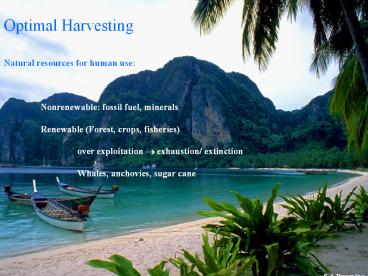Optimal Harvesting - PowerPoint PPT Presentation
1 / 18
Title:
Optimal Harvesting
Description:
Nonrenewable: fossil fuel, minerals. Renewable (Forest, crops, fisheries) ... Hokkaido herring(1913) Nil. 29,000 (#) Blue whale(1931) 1981 catch. Peak catch. Species ... – PowerPoint PPT presentation
Number of Views:37
Avg rating:3.0/5.0
Title: Optimal Harvesting
1
Optimal Harvesting
Natural resources for human use
Nonrenewable fossil fuel,
minerals Renewable (Forest, crops,
fisheries) over exploitation ? exhaustion/
extinction Whales, anchovies, sugar cane
S.A.Paranjpe
A.P.Gore
2
Cases of over-exploitation
Species Peak catch 1981 catch
Blue whale(1931) 29,000 () Nil
Fin whales(1938) 27,000 () Nil
Hokkaido herring(1913) 850,000 tons Nil
California sardine (1936) 640,000 tons Nil
North sea herring (1962) 1500,000 tons Negligible
A.P.Gore
S.A.Paranjpe
3
Peruvian Anchovy Fishery
A.P.Gore
S.A.Paranjpe
4
Tuskers poached for ivory- very few left in south
India. NTFP collection by tribal groups-
decline in genetic quality of Amla
fruit Sugarcane farming soil salinity, over
supply
Prudent use essential- but how?
Tragedy of commons Search for optimal
strategy MSY
A.P.Gore
S.A.Paranjpe
5
Controversy on export of
Indian bull frog Rana tigrina
Will It disappear?
A.P.Gore
S.A.Paranjpe
6
Frog-leg Export
Export to USA, EEC, Japan Export from India,
Bangladesh, Indonesia etc.
Export from India Year volume(tons) 1963
514 1970 2545 1981 4368 1983 3678
A.P.Gore
S.A.Paranjpe
7
Pro-export lobby Traders, MPEDA (marine
products export development authority)
- Arguments in favor
- Earning foreign exchange
- Employment in frog catching
Anti export lobby SPCA, conservationist
- Arguments against
- Threat of frog extinction
- Possible explosion of rice pest population
A.P.Gore
S.A.Paranjpe
8
Policy decision EXPORT BANNED Quantitative
basis none to our knowledge
Approach adopted in Gore Prayag (1993) Step
1 Estimate density capture recapture
method Step 2 use population dynamics model
with harvesting (nonlinear version ) to arrive
at optimal strategy Biometrics (1975)
Doubleday, (1980) Reed
A.P.Gore
S.A.Paranjpe
9
Density estimation capture recapture model
- Standard model
Capture occasion Before sampling Before sampling After sampling After sampling
Capture occasion Marked unmarked Fresh captures recaptures
First 0 N R 0
Second R N-R u1 m1n1 u1
Third (1-k) (Ru1) (1-k)(N-R-u1) u2 m2 n2 u2
- k fraction of frogs removed (harvested)
A.P.Gore
S.A.Paranjpe
10
Density estimationmodified capture recapture
model
- Modified model introduction of escapement-e
- and compensatory arrivals
Capture occasion Before sampling Before sampling After sampling After sampling
Capture occasion Marked unmarked Fresh captures recaptures
First 0 N R 0
Second R(1-e) R N-R u1 m1n1 u1
Third (1-k) (Ru1-n1e) (1-k) (N-R-u1 n1e) u2 m2 n2 u2
p1 R/N, p2 (Ru1-n1e) /N capture
probabilities at 2nd and 3rd occasion
A.P.Gore
S.A.Paranjpe
11
Maximum likelihood estimation
- L (N,e n1,n2,R ) C. p1m1 (1-p1)u1 p2m2
(1-p2)u2 - N,e estimated by search
Estimates in 3 villages of Maharashtra
Village Est(N)(5ha) Est(e) Density/ha
Poinje 539 0.66 107.8
Kolwan 773 0.48 154.6
Kambe 461 0.47 92.2
- Est(e) quite high
- Density 100/ha used for further calculations
A.P.Gore
S.A.Paranjpe
12
Assessment of sustainable harvest(Doubleday
model)
- Leslie matrix approach
- M- matrix of fecundity survival
- ? - diagonal (?1, ?2,, ?m1)
- ?j fraction from age class j that escapes
harvest - C vector of age wise weights
- V vector of age structure
A.P.Gore
S.A.Paranjpe
13
- Problem
- Maximize C(I - ?)MV (yield)
- By choosing ? such that
- MV V 0 increasing population
- ? MV V 0 harvesting stabilizes population
- ? to be obtained using LPP
A.P.Gore
S.A.Paranjpe
14
Results
- First attempt Age groups froglets, 1 yr old, 2
yr old, .6 yr old, above 6 yr - Harvest policy ( I- ? ) diag( 0.92,
0.02,0,0,1,1,1,1) - Harvest all 4 yr or older frogs, 92 of froglets
- Froglets useless, yield not worth efforts
- If not harvested- population explodes
- This solution not of much practical value
A.P.Gore
S.A.Paranjpe
15
- Modification
- Introduce density dependence
- E- recruits in froglet class
- g(E) proportion surviving
- g(E) ? exp(-?E)
- A simplifying Constraint
- all frogs above a threshold age should be
harvested
- Good choice 2 years (wt 100gm or above)
- Sustained yield about 12 Kg/ha
- Matches with field practice of traders
A.P.Gore
S.A.Paranjpe
16
Effect on insects?
- Argument
- Frog predator of insect
- Frog harvest may lead to increased insect
biomass
- From stomach contents food composition can be
estimated
Food composition of frogs (proportion of body wt)
Frog wt (gm) crab insect larvae
80 0.0134 0.0212 0.0141
125 0.0596 0.0077 0.0027
250 0.0427 0.0067 0.0019
450 0.0442 0.0037 negligible
A.P.Gore
S.A.Paranjpe
17
Frog population structure
- No harvesting ( 28,28,28,28,8,5,2,1)
- With harvesting
- (our policy) (93,93,0,0,0,0,0,0)
Food consumption by frogs per day (kg/ha)
crab insects Larvae
No harvest 1.12 0.18 0.08
harvest 0.79 0.25 0.14
- Harvesting increases insect predation !
A.P.Gore
S.A.Paranjpe
18
Findings
- Optimal strategy catch frogs of 100 gm or above
- Ensures sustainable yield
- Comment This was the practice of exporters
- Reason smaller frogs had no demand
- Pest control aspect
- frog diet- insects and other prey
- share of insects ? as weight of frog ?
- large frogs eat crabs
- Inference Removal of large frogs ? more small
frogs - ? higher consumption of insects
- ? no danger on pest control front
A.P.Gore
S.A.Paranjpe































